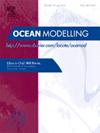基于神经网络的墨西哥湾海面漂船轨迹预测
IF 2.9
3区 地球科学
Q2 METEOROLOGY & ATMOSPHERIC SCIENCES
引用次数: 0
摘要
机器学习技术应用于拉格朗日轨迹重建,这在海洋学中非常重要,可以为搜索和救援工作提供指导,预测有害藻华的扩散,以及跟踪污染物和海洋垃圾。本研究评估了两种类型的神经网络学习海洋轨迹的能力,这些海洋轨迹来自2012年7月至10月墨西哥湾大拉格朗日部署期间释放的近250个海面漂浮物。首先,简单的全连接神经网络被训练来预测单个漂浮物在24小时和5天时间窗口内的轨迹,仅使用该漂浮物之前的速度时间序列。尽管这些网络在之前的研究中成功地学习了建模轨迹,但在进行的任何测试中,它们的表现都不及普通的自回归模型。即使根据过去的轨迹将漂流者预先分类为地理空间组,并对每个组进行不同的网络训练,以减少每个网络必须学习的可变性,情况也是如此。相比之下,一种更复杂的社会时空图卷积神经网络(STN),最初是为学习行人轨迹而开发的,由于两个重要特征,显示出更大的潜力:同时学习空间和时间模式,以及在行为相似的漂移者之间共享信息,以促进对任何特定漂移者的预测。位置预测误差在第5天平均约为60公里,比自回归低约20公里,对于某些漂移子集甚至更好。热带气旋艾萨克(Isaac)以热带风暴和一级飓风的形式经过漂移阵列,为探索这些模型在进行短24小时预测时是否会从增加风作为预测因子中受益提供了一个独特的机会。发现stn平均不受益于风,尽管某些漂移亚群在24小时有风的情况下表现出稍低的重建误差。本文章由计算机程序翻译,如有差异,请以英文原文为准。
Surface drifter trajectory prediction in the Gulf of Mexico using neural networks
Machine learning techniques are applied to Lagrangian trajectory reconstructions, which are important in oceanography for providing guidance to search and rescue efforts, forecasting the spread of harmful algal blooms, and tracking pollutants and marine debris. This study evaluates the ability of two types of neural networks for learning ocean trajectories from nearly 250 surface drifters released during the Grand Lagrangian Deployment in the Gulf of Mexico from Jul-Oct 2012. First, simple fully connected neural networks were trained to predict an individual drifter’s trajectory over 24 h and 5 d time windows using only that drifter’s previous velocity time series. These networks, despite having successfully learned modeled trajectories in a previous study, failed to outperform common autoregressive models in any of the tests conducted. This was true even when drifters were pre-sorted into geospatial groups based on past trajectories and different networks were trained on each group to reduce the variability that each network had to learn. In contrast, a more sophisticated social spatio-temporal graph convolutional neural network (STN), originally developed for learning pedestrian trajectories, demonstrated greater potential due to two important features: learning spatial and temporal patterns simultaneously, and sharing information between similarly-behaving drifters to facilitate the prediction of any particular drifter. Position prediction errors averaged around 60 km at day 5, roughly 20 km lower than autoregression, and even better for certain subsets of drifters. The passage of Tropical Cyclone Isaac over the drifter array as a tropical storm and Category 1 hurricane provided a unique opportunity to also explore whether these models would benefit from adding wind as a predictor when making short 24 h predictions. The STNs were found to not benefit from wind on average, though certain subsets of drifters exhibited slightly lower reconstruction errors at hour 24 with the addition of wind.
求助全文
通过发布文献求助,成功后即可免费获取论文全文。
去求助
来源期刊

Ocean Modelling
地学-海洋学
CiteScore
5.50
自引率
9.40%
发文量
86
审稿时长
19.6 weeks
期刊介绍:
The main objective of Ocean Modelling is to provide rapid communication between those interested in ocean modelling, whether through direct observation, or through analytical, numerical or laboratory models, and including interactions between physical and biogeochemical or biological phenomena. Because of the intimate links between ocean and atmosphere, involvement of scientists interested in influences of either medium on the other is welcome. The journal has a wide scope and includes ocean-atmosphere interaction in various forms as well as pure ocean results. In addition to primary peer-reviewed papers, the journal provides review papers, preliminary communications, and discussions.
 求助内容:
求助内容: 应助结果提醒方式:
应助结果提醒方式:


